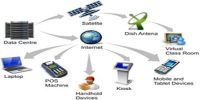A database management system (DBMS) is a software package designed to de me, manipulate, retrieve and manage data in a database. A DBMS generally manipulates the data itself, the data format, field names, record structure, and file structure. It provides users and programmers with a systematic way to create, retrieve, update and manage data.
Database Management System Functions: The Database Management System performs the following functions:
- Data Dictionary Management,
- Data Storage Management,
- Data Transformation and Presentation,
- Security Management,
- Multi-User Access Control,
- Backup and Recovery Management,
- Data Integrity Management,
- Database Access Languages and Application Interface,
- Database Communication Interface.
(a) Data Dictionary Management
The data dictionary stores the definitions of data elements and their relationships. This information is termed as metadata. The metadata includes definition of data, data types, relationship between data, integrity constraints etc. Any changes made in a database structure are automatically reflected in the data dictionary. In short the DBMS provides data abstraction and it removes structural and data dependency from the system.
(b) Data Storage Management
The DBMS creates the complex structures required for data storage. The users are freed from defining, programming and implementing the complex physical data characteristics.
(c) Data Transformation and Presentation:
DBMS supports data independence. Hence the DBMS translate logical request into commands that physically locate and retrieve the requested data. The DBMS formats the physically retrieved data according to the logical data format specifications.
(d) Security Management:
The DBMS creates a security system that enforces user security and data privacy within the database. Security rules determine the access rights of the users. Read/write access is given to the user is specified using access rights.
(e) Multiuser Access Control:
The DBMS ensures that multiple users can access the database concurrently without compromising the integrity of the database. Hence the database ensures data integrity and data consistency.
(f) Backup and Recovery Management:
The DBMS provide backup and data recovery procedures to ensure data safety and integrity. DBMS system provides special utilities which allow the DIM to perform routine and special backup and restore procedures. Recovery Management deals with the recovery of the database after a failure.
(g) Data Integrity Management:
The DBMS promotes and enforce integrity rules to eliminate data integrity problems, thus minimizing the data redundancy and maximizing data consistency.
(h) Database Access Languages and Application Interface:
The DBMS provides data access via query language. A query language is a non-procedural language that is the user only need to specify what must be done without specifying how it is to be done. The DBMS’s query language contains two components: a data definition language (DDL) and a data manipulation language (DML). The DBMS also provide data access to programmers via programming languages.
(i) Database Communication Interfaces:
Different users may access the database through a network environment. So the DBMS provide communication functions to access the database through computer network environment.
















